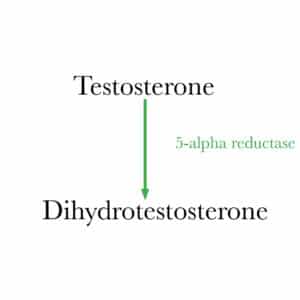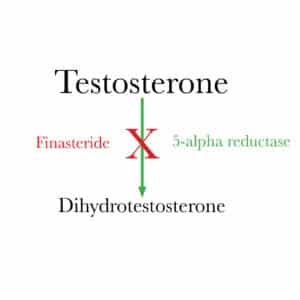Dr. Steven Gabel offers his patients many treatment options for hair restoration and strives to stay on the cutting edge of modern medicine. Finasteride is an important medication to learn about.
One of the most common medications for treating male pattern baldness is the use of the medication finasteride, known better by the brand names Propecia (1-mg tablet) and Propecia (5-mg tablet). It is the only FDA approved oral medication that is proven to effectively treat male pattern baldness (androgenetic alopecia).
Finasteride requires a physician’s prescription and only a thorough consultation with a qualified doctor can determine your best course of action for pursuing a medical treatment for your hair loss.
The Root of Male Pattern Baldness
Male pattern baldness is the most common cause of hair loss in men. Since male pattern baldness behaves in a progressive fashion, about a quarter of the men who have this condition will begin noticing hair loss as early as their teens, even before they reach 21.
As men age, 1 in 4 will notice thinning or baldness by the time they reach the age of 30. And by age 40 studies indicate that up to half of all men will notice cosmetically apparent hair loss.
Men who have male pattern baldness will lose their hair in a predictable pattern, typically defined on the Norwood Scale, beginning with the recession of the temples and then advancing over time to form a typical “M” shape as the hair line further recedes back and thins. Hair loss can also involve the crown, gradually advancing until the entire front, top, and crown are bald or very thin.
Male pattern baldness is caused by the effects of the male hormone dihydrotestosterone (DHT) on genetically susceptible hair follicles located in the front, top, and crown of the scalp. People with male pattern baldness are genetically predisposed to the DHT hormone that causes the miniaturization of their susceptible hair follicles, which shrink in size, both in diameter and length. As a result, the miniaturized follicle eventually produces a small, unpigmented vellus hair rather than the usual pigmented, normal terminal hair.
DHT also shortens the susceptible follicle’s growth (anagen) phase. These two effects cause the hair to become progressively shorter and finer until it eventually disappears to the naked eye and is no longer viable.
How Finasteride Works in The Body
Normally in men, the hormone testosterone is converted to the hormone DHT by the enzyme 5-alpha reductase.

Finasteride works by blocking an enzyme 5-alpha reductase thereby significantly reducing the amount of DHT that the body produces. By blocking this enzyme, a patient can effectively lower the DHT in their body and spare their hair from the effects of DHT. This results in hair that maintains its shape effectively reducing miniaturization of the hairs. Finasteride causes a significant drop in both the scalp and the blood levels of DHT. Finasteride 1-mg/day decreases serum DHT levels by almost 70%.

Clinical Studies of Finasteride
Controlled studies have shown that after five years of treatment, 90% of men taking finasteride experienced either a growth of new hair or a halt to their hair loss. Specifically, after five years, 48% of men demonstrated an increase in hair growth, 42% were rated as having no new hair loss while the remaining 10% were rated as having lost hair.
In contrast, 6% of men treated with a placebo demonstrated an increase in hair growth, 19% were rated as having no new hair loss while the remaining 75% were rated as having lost hair.
In the “Hair Count Clinical Study,” hair counts showed an average gain of 277 hairs per one-inch circle at the end of five years of observation. These hairs were significantly larger than the fine, miniaturized hair characteristic of balding men.
In the “Hair Weight Clinical Study,” a 34% increase in hair weight was observed between finasteride and the placebo after 96 weeks of clinical observation. By increasing hair weight, that effectively gives patients more volume, and ultimately a fuller appearance of hair.
Can Finasteride Help Preserve the Frontal Scalp?
Finasteride is often used to protect hair on the crown and top of the head from DHT’s effects, with some claiming it is less effective at preserving the frontal scalp and hairline from hair loss. However, there is published data from a controlled clinical trial of men with frontal hair loss that demonstrates improvement in the frontal region of the scalp. The efficacy of finasteride to retard or slow down hair loss is universal to all areas of the scalp so long as there is some hair in the area.
Although their mechanisms for promoting hair growth are different, both finasteride and minoxidil act to thicken miniaturized hair regardless of where it is on the scalp.
How Soon Can I See Results?
Finasteride should be taken once daily. Patients must commit to taking finasteride for one year or longer before its effects in preventing hair loss and re-growing hair can be accurately assessed. Finasteride takes up to a year or more to show its full effects in both preventing hair loss and in re-growing hair. During the first six months you may note some unwelcome thinning of your existing hair. This may be due to either progression of your hair loss before starting a finasteride regimen or some shedding of miniaturized hair that makes way for the new healthy anagen hair to grow.
It is important to be absolutely patient during this period of time. You should continue the medication for at least one year before you and your doctor can assess its benefits. If finasteride is able to benefit you in stalling or even stopping your hair loss, it will require a lifetime commitment to taking finasteride to maintain the results.
What Are Potential Side Effects?
Side effects from finasteride at the recommended 1-mg dose are uncommon, but ultimately reversible if they should occur. The one-year drug related side effects were 1.5% greater than in the control group. The compiled data showed that 3.8% of men taking finasteride 1mg experienced some form of sexual dysfunction verses 2.1% in men treated with a placebo. The five-year side effects profile included: decreased libido (0.3%), erectile dysfunction (0.3%), and decreased volume of ejaculate (0.0%).
Most cases of sexual dysfunction occurred soon after starting the medication, but there have been reports of sexual dysfunction that have occurred at later points in time. The sexual side effects were reversed in those who discontinued the medication, and in 58% of those who continued treatment the sexual dysfunction was overcome. After the medication is stopped, side effects generally disappear within a few weeks. Anecdotal reports exist where side effects have persisted after discontinuation of therapy, but no clinical trials confirm the claims. This had been referred to as “Post-finasteride syndrome.”
When finasteride is discontinued, all of the hair that had been gained or preserved by the medication is soon lost in the coming weeks or months. In effect, the patient returns to the level of balding where he would have been had he never used the medication in the first place.
Finasteride is not known to cause complications with any other drugs of clinical importance.
Finasteride may decrease fertility in some men, studies are not conclusive in the matter at this time. The effects may be due to changes in the composition of ejaculate and/or a reduction in sperm count. The effects appear to be reversible by simply discontinuing the medication.
What Are the Long-Term Benefits?
The positive effects of finasteride are seen in areas of the scalp that are thinning, but where there is still some hair present. In other words, finasteride does not reverse complete baldness.
It can not promote hair growth in areas that are completely bald. Although it can regrow hair in thin areas, the major benefit of finasteride seems to be in its ability to slow down or halt hair loss. Positive results typically peak around one year after beginning a finasteride regimen.
Results remain stable in the second year or show an almost negligible decrease. Although the long-term ability of finasteride to maintain one’s hair is not fully known, the majority of men find that after 5 years the medication is still maintaining their hair from further thinning or baldness.
The benefits of finasteride will stop if the medication is ever discontinued. Over the 2-6 months following discontinuation, the hair loss pattern will generally return to the state that it would have been if the medication had never been used.
If a patient ever discontinues the medication for extended periods they should be aware that they may forfeit whatever gains were made by having used the medication.
Should I Use Finasteride After A Hair Transplantation?
Absolutely, finasteride has shown itself to be useful in complementing a hair transplant for the following reasons:
Finasteride works best in younger patients who may not yet be a candidate for hair transplantation and need to preserve as much hair as they can until they’ve stabilized their hair loss and are old enough to consider a surgical approach.
Finasteride is less effective in the front part of the scalp than it is at protecting the crown. The lion’s share of surgical hair restoration is used to offer a cosmetic benefit to the frontal scalp and hairline.
Finasteride can re-grow hair, or at least stabilize hair loss, in the back part of the scalp and effectively make future hair restoration to the back of the head unwarranted even if hair loss exists in the frontal scalp.
For those who choose not to take finasteride because they fear potential side effects, or who cannot take it due to being in the minority of people who experience the side effects, then surgical hair restoration is still highly effective. The only difference is that medications can prevent further hair loss whereas surgery cannot.
Medications are not needed for a hair transplant to be successful or the transplanted hair to grow and be permanent.
But medications exist as preventative treatment, mitigating the need for restoration procedures in the future.
Can I Use Generic Finasteride Instead of Name Brands?
Finasteride 5mg (Proscar) and 1mg (Propecia) are available in generic formulations and are much more cost effective. For those wanting to pursue the most inexpensive route, it is recommended to buy a pill cutter taking ¼ of a 5mg tablet every day.
Most generic brands are just as effective as the name brands; but, if you have consumer confidence issues in your pharmacy’s generics then consider using name brands to ensure the integrity of your finasteride’s effectiveness.
Contact The Gabel Center
To learn more about hair loss and the latest medications and the latest techniques in hair restoration and hair transplant surgery, contact our Portland hair transplant surgery center today. Our team at the Gabel Center look forward to your visit and discussing these matters with you in greater detail.
